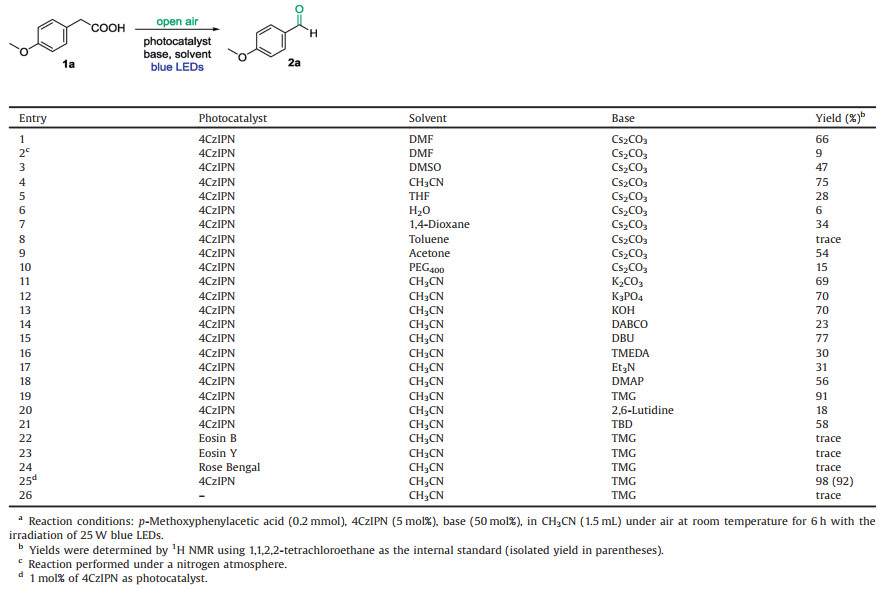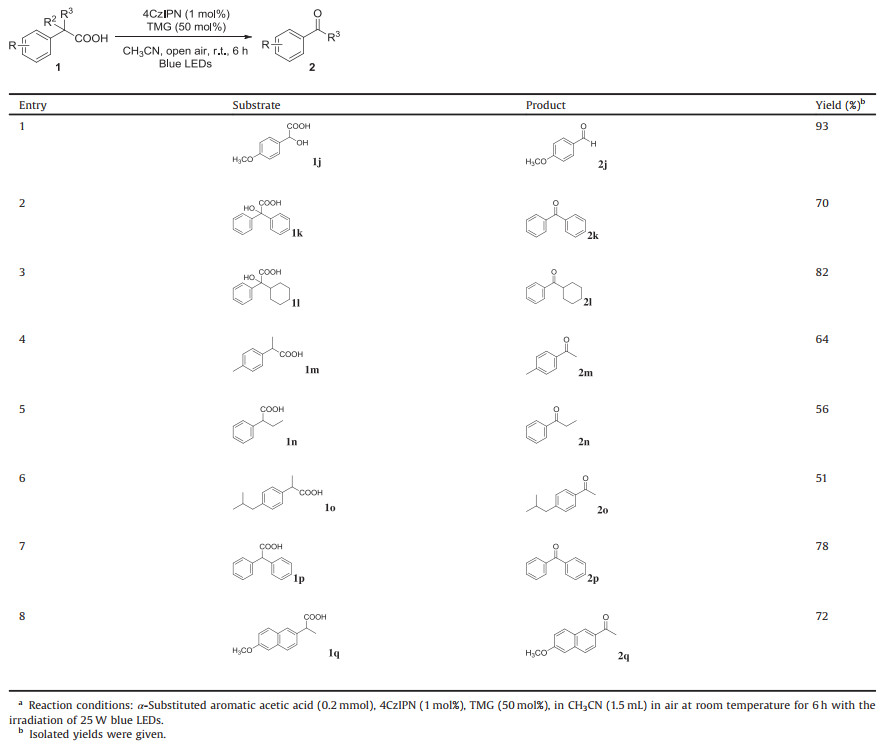b Henan Nonferrous Metals Geological Exploration Institute, Zhengzhou 450052, China;
c Hunan Provincial Key Laboratory of Materials Protection for Electric Power and Transportation, Changsha University of Science and Technology, Changsha 410114, China
Due to their easy availability, carboxylic acids have been widely applied as inexpensive starting materials and building blocks for organic synthesis. Decarboxylation reaction is one of the most useful transformations of carboxylic acids [1-5]. Over the past few decades, a myriad of strategies have been developed for decarboxylation of carboxylic acids to synthesize new compounds [6-14]. Among them, transition-metal-catalyzed decarboxylation of sp-hybridized and sp2-hybridized carboxylic acids has been extensively explored in previous reports [15-17]. However, the decarboxylation of saturated sp3-hybridized carboxylic acids is still a daunting challenge due to the inert nature of the C—C σ bond [18-20]. Moreover, the requirements of transition-metal catalysts, stoichiometric toxic oxidant, and high temperature in those previous reported systems have limited their applications.
Aromatic aldehydes and ketones are important compounds, displaying a wide range of applications in organic synthesis. One of the most straightforward strategies for the synthesis of aromatic aldehydes and ketones is oxidative decarboxylation of corresponding arylacetic acids [21-25]. For example, Mirkhani and co-workers reported a series of transition-metal-catalyzed procedures (e.g., Mn [26] and Fe [27]) for the oxidative decarboxylation of arylacetic acids in the presence of complex ligands and additional strong oxidants. In 2014, the Song's group developed an elegant Cu(OAc)2- catalyzed aerobic oxidative decarboxylation of phenylacetic acid to synthesize the aldehydes and ketones in sealed tubes under 120 ℃ (Scheme 1a) [25]. Recently, Bhat and co-workers achieved the same oxidative decarboxylation reaction of arylacetic acid with K2S2O8 as oxidant. Notably, the excess amount of K2S2O8 (2 equiv.) and high temperature (90 ℃) were required (Scheme 1b) [21]. Although remarkable advances have been made, previous methods equired stoichiometric oxidants and high temperature, which may limit their applications. From the point view of green chemistry, the exploration of a metal-free catalytic system with green oxidants (ideally atmosphere pressure of oxygen or air) under mild conditions is highly desired [28-30].
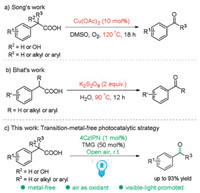
|
Download:
|
| Scheme 1. Oxidative decarboxylation of phenylacetic acids. | |
As a rapidly developing field, visible-light-promoted reactions have drawn huge attention in recent years [31-51]. Particularly, 1, 2, 3, 5-tetrakis(carbazol-9-yl)-4, 6-dicyanobenzene (4CzIPN) has proven to be an efficient metal-free photocatalyst for the transformations of carboxylic acids in organic synthesis, medicine and materials [52-57]. In the course of our continuing efforts on green chemistry [58-61], we herein disclosed a 4CzIPN-catalyzed transition-metal-free procedure to achieve the oxidative decarboxylation of arylacetic acids toward the corresponding aromatic aldehydes and ketones at room temperature under visible-light illumination (Scheme 1c). Importantly, in this procedure air is the sole oxidant, which eliminate the need for large quantities of oxidants. This strategy circumvents the use of transition-metal catalysts and traditional heating.
We started our study using 4-methoxyphenylacetic acid (1a) as the model substrate in the presence of 4CzIPN and Cs2CO3 under visible-light (Table 1). To our delight, the reaction with 4CzIPN (5 mol%) as photocatalyst and Cs2CO3 (50 mol%) as additive in air under the irradiation of blue light gave the desired aldehyde 2a in 66% yield (entry 1). While the same reaction under nitrogen atmosphere only delivered the product 2a in 9% yield (entry 2). Such a finding suggested that the oxidative decarboxylation of 1a with 4CzIPN as photocatalyst and air as the sole oxidant is possible. Subsequently, various solvents including DMSO, CH3CN, THF, H2O, 1, 4-dioxane, toluene, acetone and PEG400 were surveyed in the presence of 4CzIPN/Cs2CO3 (entries 3–10). It was found that the reaction in CH3CN gave a higher yield of 2a up to 75%, indicating CH3CN is the optimal solvent for this transformation (entry 4). Next, the effects of different bases on the reaction were investigated. The inorganic bases like K2CO3, K3PO4, KOH, and the organic bases such as DABCO (1, 4-diazabicyclo[2.2.2]octane), DBU (1, 8-diazabicyclo[5.4.0]undec-7-ene), TMEDA (tetramethylethyle-nediamine), Et3N, DMAP (dimethylaminopyridine), TMG (1, 1, 3, 3-tetramethylguanidine), 2, 6-lutidine, and TBD (1, 5, 7-tria-zabicyclo[4.4.0]dec-5-ene) were screened respectively with 4CzIPN (5 mol%) as photocatalyst in CH3CN under blue light irradiation (entries 11–21). The results indicated that TMG was superior to the others and the yield was as high as 91% (entry 19). Then, some organic photocatalysts such as Eosin B, Eosin Y, Rose Bengal were applied as catalysts in the presence of TMG (50 mol%) in CH3CN for 6 h under air at room temperature, respectively (entries 22–24). However, the oxidative decarboxylation reactions almost did not work. Furthermore, it is delighted to find that even the catalyst loading of 4CzIPN was reduced to 1 mol%, the reaction performance was almost maintained giving the product 2a in 92% of isolated yield (entry 25). Additionally, the control experiment without any photocatalyst only gave trace amount of product 2a (entry 26). These results suggested the application of 4CzIPN as a photocatalyst and the irradiation of blue light were critical for such an efficient transformation. Finally, the optimal conditions were established as follows: 1a (0.2 mmol), 4CzIPN (1 mol%), TMG (50 mol%), CH3CN (1.5 mL) under air at room temperature for 6 h with the irradiation of 25 W blue LEDs.
|
|
Table 1 Optimization of reaction conditions.a |
With the optimum conditions in hand, we further explored the scope of this visible-light-induced 4CzIPN-catalyzed oxidative decarboxylation reaction via the reaction of some commercially available arylacetic acids 1 (Scheme 2). When the phenylacetic acids bearing methoxy group at ortho- or para-positions, 92% and 80% yields of corresponding products 2a or 2b were obtained, respectively. However, the phenylacetic acid with meta-substituted methoxy group gave relatively poor yield of the aldehydes 2c. These results suggested that the position of the substituents on the aromatic rings had a significant effect on the reactivity. When the phenylacetic acids with methyl or tert-butyl group at para-position, the oxidative decarboxylation reaction also showed good reactivities, giving the corresponding aldehydes 2d and 2e in moderate yields (40% and 55%). Unfortunately, only 25% yield of 2f was observed when the -Cl containing phenylacetic acid was employed as substrate. In the cases of 2c and 2f, no obvious improvements were observed even with higher catalyst loading (2 mol%) and longer reaction time (12 h). Notably, no byproducts were observed in those cases, suggesting that the low yields were probably due to the low reactivity of those substrates. Interestingly, 1-naphthylacetic acid and 2-naphthylacetic acid were also applicable in this procedure, affording the desired aldehydes 2g and 2h in 45% and 60% yields. Moreover, the heteroaromatic acid such as 2-(thiophen-2-yl)acetic acid was also suitable in this reaction delivering the thiophene-2-carbaldehyde 2i in 63% yield under standard conditions.
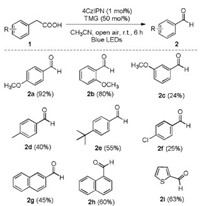
|
Download:
|
| Scheme 2. Oxidative decarboxylation of arylacetic acids to aldehydes. Reaction conditions: Arylacetic acid (0.2 mmol), 4CzIPN (1 mol%), TMG (50 mol%), in CH3CN (1.5 mL) in air at room temperature for 6 h with the irradiation of 25 W blue LEDs. Isolated yields were given. | |
Additionally, a scale-up reaction (10 mmol-scale) for the model reaction was conducted under the identical conditions. Delightfully, a great yield (84%) of the desired product 2a was isolated after prolonging the reaction time to 15 h, demonstrating this simple photocatalytic systemis practical and potentially useful (Scheme 3).

|
Download:
|
| Scheme 3. The gram-scale synthesis of 2a. | |
In order to expand the scope of this reaction under standard conditions, we then explored the reaction with α-substituted aromatic acetic acids as substates under optimal reaction conditions (Table 2). To our delight, when α-hydroxy-p-methoxyphenylacetic acid 1j was employed as reactant, the corresponding aldehyde 2j was obtained in excellent yield of 93%. Next, we used 2-hydroxy-2, 2-diphenylacetic acid 1k and 2-cyclohexyl-2-hydroxy-2-phenylacetic acid 1l as substrates, the corresponding products, benzophenone 2k and cyclohexyl(phenyl)methanone 2l were obtained in good yields of 70% and 82%, respectively. On this basis, a series of ketones (2m-2q) were synthesized from the α-substituted phenyl acetic acids (1m-1q) under the standard reaction conditions in moderate to good yields (51%–78%). Moreover, the aliphatic substrate, e.g., cyclohexanecarboxylic acid did not give any product, indicating that aliphatic carboxylic acids are not suitable in this protocol.
|
|
Table 2 Oxidative decarboxylation of α-substituted aromatic acetic acid to aldehydes and ketones.a |
To gain a deeper insight into the mechanism of this photocatalysis reaction, the control experiments were conducted as described. When the model reaction was treated with 5 equiv. of 2, 2, 6, 6-tetramethyl-1-piperidinyloxy (TEMPO), the reaction was totally suppressed and no product 2a was detected (Scheme 4). This result revealed that a radical pathway was probably involved in the reaction process.

|
Download:
|
| Scheme 4. Control experiments. | |
Furthermore, the Stern-Volmer quenching experiments was carried out by separately adding various components of the reaction system to the degassed anhydrous CH3CN solution containing 4CzIPN. However, none of the reactants had obvious fluorescence quenching effect on the photocatalyst (Supporting information). Considering that it is an aerobic reaction, the experiment of oxygen quenching was carried out later. As expected, molecular oxygen showed a signifcant fluorescence quenching effect on the photocatalyst. The linear relationship between I0/I (I0 and I are the fluorescence intensities before and after the O2 was bubbled into the solution, respectively) and the time for oxygen bubbling indicates that O2 may quench 4CzIPN (Supporting information). When the superoxide radical (O2·-) scavenger 4-benzoquinone (BQ) was added to the model reaction [62], the yield of 2a was reduced to 18%, which suggesting the generation of superoxide radical (O2·-) in the oxidative decarboxylation reaction, which was further confirmed by EPR spectroscopy [63] (Supporting Information).
Based on the above results and previous reports [64], a plausible reaction mechanism was proposed as shown in Scheme 5. Under blue-light irradiation, 4CzIPN was excited to produce the corresponding excited-state 4CzIPN*, which is sufficiently reductive (E1/2(P·+/P*) = -1.04 V vs. SCE [52]) to donate an electron to O2 generating the superoxide radical O2·- (Ered = -0.86 V vs. SCE [65]) along with the release highly oxidative 4CzIPN·+. In the presence of base, carboxylic acid 1 was deprotonated to give the carboxylate anion A. The highly oxidative 4CzIPN·++ (Eox(P·+/P) = +1.52 V vs. SCE [52]) was able to oxidize the carboxylate anion A (Eox = +1 ~ +1.25 V vs. SCE [66]) producing the radical B and regenerating the photocatalyst 4CzIPN. Subsequently, the elimination of CO2 from radical B gave the benzylic radical C, which then combined with superoxide radical (O2·-) to give the anion D. Finally, the anion D was protonated to deliver the intermediate E, followed by dehydration to produce the desired product 2.
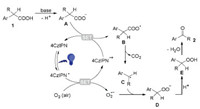
|
Download:
|
| Scheme 5. The Proposed mechanism. | |
In conclusion, we have developed a photocatalytic protocol for the oxidative decarboxylation of phenylacetic acid derivatives to synthesize corresponding aromatic aldehydes or ketones. This reaction can be carried out in air at room temperature by using 1 mol% of 4CzIPN as photocatalyst. This transition-metal-free procedure avoids the use of excess amount of inorganic/organic oxidants and high temperature. The employment of air as green oxidant eliminate the generation of waste from traditional oxidants. Further research for the application of such a oxidative carboxylation strategy is underway in our research group.
Declaration of competing interestThe authors declare that they have no known competing financial interests or personal relationships that could have appeared to influence the work reported in this paper.
AcknowledgmentsWe acknowledge the financial support from the National Natural Science Foundation of China (Nos. 21501010, 21971224), Innovation and Entrepreneurship Training Program of Zhengzhou University (No. 2019cxcy509), and Hunan Provincial Key Laboratory of Materials Protection for Electric Power and Transportation (No. 2019CL03).
Appendix A. Supplementary dataSupplementary material related to this article can befound, in the online version, at doi:https://doi.org/10.1016/j.cclet.2019.12.031.
| [1] |
L.J. Gooßen, N. Rodriguez, K. Gooßen, Angew. Chem. Int. Ed. 47 (2008) 3100-3120. DOI:10.1002/anie.200704782 |
| [2] |
Y. Wei, P. Hu, M. Zhang, W. Su, Chem. Rev. 117 (2017) 8864-8907. DOI:10.1021/acs.chemrev.6b00516 |
| [3] |
L.N. Guo, H. Wang, X.H. Duan, Org. Biomol. Chem. 14 (2016) 7380-7391. DOI:10.1039/C6OB01113F |
| [4] |
L. Peng, Z. Hu, Z. Tang, Y. Jiao, X. Xu, Chin. Chem. Lett. 30 (2019) 1481-1487. DOI:10.1016/j.cclet.2019.04.008 |
| [5] |
W.M. Zhao, X.L. Chen, J.W. Yuan, et al., Chem. Commun. 50 (2014) 2018-2020. DOI:10.1039/c3cc48069k |
| [6] |
H.H. Zhang, S. Yu, Org. Lett. 21 (2019) 3711-3715. DOI:10.1021/acs.orglett.9b01169 |
| [7] |
M. Rahman, A. Mukherjee, I.S. Kovalev, et al., Adv. Synth. Catal. 361 (2019) 2161-2214. DOI:10.1002/adsc.201801331 |
| [8] |
L. Liu, J. Dong, Y. Yan, et al., Chem. Commun. 55 (2019) 233-236. DOI:10.1039/C8CC08689C |
| [9] |
G. Hong, J. Yuan, J. Fu, et al., Org. Chem. Front. 6 (2019) 1173-1182. DOI:10.1039/C9QO00105K |
| [10] |
M.C. Fu, R. Shang, B. Zhao, B. Wang, Y. Fu, Science 363 (2019) 1429-1434. DOI:10.1126/science.aav3200 |
| [11] |
Y. Zhao, J.R. Chen, W.J. Xiao, Org. Lett. 20 (2018) 224-227. DOI:10.1021/acs.orglett.7b03588 |
| [12] |
J.F. Zhao, X.H. Duan, Y.R. Gu, P. Gao, L.N. Guo, Org. Lett. 20 (2018) 4614-4617. DOI:10.1021/acs.orglett.8b01901 |
| [13] |
X. Zhang, X. Feng, C. Zhou, et al., Org. Lett. 20 (2018) 7095-7099. DOI:10.1021/acs.orglett.8b03043 |
| [14] |
J. Li, M. Kong, B. Qiao, et al., Nat. Commun. 9 (2018) 2445. DOI:10.1038/s41467-018-04885-3 |
| [15] |
F. Bilodeau, M.C. Brochu, N. Guimond, K.H. Thesen, P. Forgione, J. Org. Chem. 75 (2010) 1550-1560. DOI:10.1021/jo9022793 |
| [16] |
Q. Feng, K. Yang, Q. Song, Chem. Commun. 51 (2015) 15394-15397. DOI:10.1039/C5CC05084G |
| [17] |
D. Zhao, C. Gao, X. Su, et al., Chem. Commun. 46 (2010) 9049-9051. DOI:10.1039/c0cc03772a |
| [18] |
Q. Feng, Q. Song, Adv. Synth. Catal. 356 (2014) 1697-1702. DOI:10.1002/adsc.201301001 |
| [19] |
H. Hu, X. Chen, K. Sun, et al., Org. Chem. Front. 5 (2018) 2925-2929. DOI:10.1039/C8QO00882E |
| [20] |
K. Sun, S.J. Li, X. Chen, et al., Chem. Commun. 55 (2019) 2861-2864. DOI:10.1039/C8CC10243K |
| [21] |
T.B. Mete, T.M. Khopade, R.G. Bhat, Tetrahedron Lett. 58 (2017) 2822-2825. DOI:10.1016/j.tetlet.2017.06.013 |
| [22] |
D. Baruah, D. Konwar, Catal. Commun. 69 (2015) 68-71. DOI:10.1016/j.catcom.2015.05.029 |
| [23] |
F.L. Hussain, M. Suri, A. Namdeo, et al., Catal. Commun. 124 (2019) 76-80. DOI:10.1016/j.catcom.2019.01.011 |
| [24] |
S. Farhadi, P. Zaringhadam, R.Z. Sahamieh, Tetrahedron Lett. 47 (2006) 1965-1968. DOI:10.1016/j.tetlet.2006.01.082 |
| [25] |
Q. Feng, Q. Song, J. Org. Chem. 79 (2014) 1867-1871. DOI:10.1021/jo402778p |
| [26] |
V. Mirkhani, S. Tangestaninejad, M. Moghadam, M. Moghbel, Biorg. Med. Chem. 12 (2004) 903-906. DOI:10.1016/j.bmc.2003.12.025 |
| [27] |
M. Montazerozohori, M. Nasr-Esfahani, P. Akhlaghi, Chin. J. Chem. 27 (2009) 1007-1011. DOI:10.1002/cjoc.200990143 |
| [28] |
F.L. Zeng, X. Chen, S.Q. He, et al., Org. Chem. Front. 6 (2019) 1476-1480. DOI:10.1039/C9QO00091G |
| [29] |
K.J. Liu, S. Jiang, L.H. Lu, et al., Green Chem. 20 (2018) 3038-3043. DOI:10.1039/C8GC00223A |
| [30] |
R. Li, X. Chen, S. Wei, et al., Adv. Synth. Catal. 360 (2018) 4807-4813. DOI:10.1002/adsc.201801122 |
| [31] |
Y. Liu, X.L. Chen, K. Sun, et al., Org. Lett. 21 (2019) 4019-4024. DOI:10.1021/acs.orglett.9b01175 |
| [32] |
X.C. Liu, K. Sun, X.L. Chen, et al., Adv. Synth. Catal. 361 (2019) 3712-3717. DOI:10.1002/adsc.201900544 |
| [33] |
R. Li, T. Shi, X.L. Chen, et al., New J. Chem. 43 (2019) 13642-13646. DOI:10.1039/C9NJ03692J |
| [34] |
Y. Cao, N. Wang, X. He, H.R. Li, L.N. He, ACS Sustainable Chem. Eng. 6 (2018) 15032-15039. DOI:10.1021/acssuschemeng.8b03498 |
| [35] |
W. Wei, L. Wang, P. Bao, et al., Org. Lett. 20 (2018) 7125-7130. DOI:10.1021/acs.orglett.8b03079 |
| [36] |
D.M. Yan, J.R. Chen, W.J. Xiao, Angew. Chem. Int. Ed. 58 (2019) 378-380. DOI:10.1002/anie.201811102 |
| [37] |
Q.Q. Zhou, Y.Q. Zou, L.Q. Lu, W.J. Xiao, Angew.Chem.Int.Ed. 58 (2019) 1586-1604. DOI:10.1002/anie.201803102 |
| [38] |
K. Shimomaki, K. Murata, R. Martin, N. Iwasawa, J. Am. Chem. Soc. 139 (2017) 9467-9470. DOI:10.1021/jacs.7b04838 |
| [39] |
Y. Chen, L.Q. Lu, D.G. Yu, C.J. Zhu, W.J. Xiao, Sci. China Chem. 62 (2019) 24-57. DOI:10.1007/s11426-018-9399-2 |
| [40] |
Q. Liu, L. Wang, H. Yue, et al., Green Chem. 21 (2019) 1609-1613. DOI:10.1039/C9GC00222G |
| [41] |
J. Xuan, W.J. Xiao, Angew. Chem. Int. Ed. 51 (2012) 6828-6838. DOI:10.1002/anie.201200223 |
| [42] |
S. Zhang, Z. Tan, H. Zhang, et al., Chem. Commun. 53 (2017) 11642-11645. DOI:10.1039/C7CC06252D |
| [43] |
W. Wei, H. Cui, H. Yue, D. Yang, Green Chem. 20 (2018) 3197-3202. DOI:10.1039/C8GC01245H |
| [44] |
S.S. Yan, L. Zhu, J.H. Ye, et al., Chem. Sci. 9 (2018) 4873-4878. DOI:10.1039/C8SC01299G |
| [45] |
X.Z. Fan, J.W. Rong, H.L. Wu, et al., Angew. Chem. Int. Ed. 57 (2018) 8514-8518. DOI:10.1002/anie.201803220 |
| [46] |
B. Kang, S.H. Hong, Chem. Sci. 8 (2017) 6613-6618. DOI:10.1039/C7SC02516E |
| [47] |
R.Z. Mao, L.F. Sun, Y.S. Wang, et al., Chin. Chem. Lett. 29 (2018) 61-64. DOI:10.1016/j.cclet.2017.08.005 |
| [48] |
M. Zhang, L. Yang, H. Yang, G. An, G. Li, ChemCatChem 11 (2019) 1606-1609. DOI:10.1002/cctc.201802079 |
| [49] |
C.A. Roberts, S.P. Phivilay, I.E. Wachs, Chin. Chem. Lett. 29 (2018) 769-772. DOI:10.1016/j.cclet.2017.09.029 |
| [50] |
X. Hu, S. Lu, J. Tian, et al., Appl. Catal. B:Environ. 241 (2019) 329-337. DOI:10.1016/j.apcatb.2018.09.051 |
| [51] |
Y. Ge, P. Diao, C. Xu, N. Zhang, C. Guo, Chin. Chem. Lett. 29 (2018) 903-906. DOI:10.1016/j.cclet.2018.01.002 |
| [52] |
T.Y. Shang, L.H. Lu, Z. Cao, et al., Chem. Commun. 55 (2019) 5408-5419. DOI:10.1039/C9CC01047E |
| [53] |
J. Guo, G.B. Huang, Q.L. Wu, et al., Org. Chem. Front. 6 (2019) 1955-1960. DOI:10.1039/C9QO00380K |
| [54] |
K. Donabauer, M. Maity, A.L. Berger, et al., Chem. Sci. 10 (2019) 5162-5166. DOI:10.1039/C9SC01356C |
| [55] |
J. Guo, Q.L. Wu, Y. Xie, J. Weng, G. Lu, J. Org. Chem. 83 (2018) 12559-12567. DOI:10.1021/acs.joc.8b01849 |
| [56] |
H. Huang, G. Zhang, Y. Chen, Angew. Chem. Int. Ed. 54 (2015) 7872-7876. DOI:10.1002/anie.201502369 |
| [57] |
H. Yang, C. Tian, D. Qiu, et al., Org. Chem. Front. 6 (2019) 2365-2370. DOI:10.1039/C9QO00495E |
| [58] |
X. Feng, T. Yang, X. He, B. Yu, C.W. Hu, Appl. Organomet. Chem. 32 (2018) e4314. DOI:10.1002/aoc.4314 |
| [59] |
G.P. Yang, D. Dilixiati, T. Yang, et al., Appl. Organomet. Chem. 32 (2018) e4450. DOI:10.1002/aoc.4450 |
| [60] |
B. Yu, B. Zou, C.W. Hu, J. CO2 Util. 26 (2018) 314-322. DOI:10.1016/j.jcou.2018.05.021 |
| [61] |
G.P. Yang, X. Wu, B. Yu, C.W. Hu, ACS Sustainable Chem. Eng. 7 (2019) 3727-3732. DOI:10.1021/acssuschemeng.8b06445 |
| [62] |
W. Yu, Z. Zhao, Org. Lett. 21 (2019) 7726-7730. DOI:10.1021/acs.orglett.9b02569 |
| [63] |
D. Jing, C. Lu, Z. Chen, et al., Angew. Chem. Int. Ed. 58 (2019) 14666-14672. DOI:10.1002/anie.201906112 |
| [64] |
Q. Lu, P. Peng, Y. Luo, et al., Chem. -Eur. J. 21 (2015) 18580-18583. DOI:10.1002/chem.201503716 |
| [65] |
C. Su, R. Tandiana, B. Tian, et al., ACS Catal. 6 (2016) 3594-3599. DOI:10.1021/acscatal.6b00443 |
| [66] |
L. Capaldo, L. Buzzetti, D. Merli, M. Fagnoni, D. Ravelli, J. Org. Chem. 81 (2016) 7102-7109. DOI:10.1021/acs.joc.6b00984 |
 2020, Vol. 31
2020, Vol. 31  Scheme 1
Scheme 1



